Exploration Technology
Seismic source offerings provide options for operators
Has everything really been tried? Considering the whole acquisition package, what’s old might be worth another look.
Perry A. Fischer, Editor
Any device that releases acoustic energy could be considered a seismic source, and there are many. Historically, one would think that just about everything imaginable has been used. However, amazingly, folks are still coming up with new ideas, or more often, a new twist on an old idea that had previously created problems – some of which can now be solved. This article takes a look at the past, and then presents new, non-explosive devices.
BRIEF HISTORY
It was 1921 in south Oklahoma when reflection seismic was first used for subsurface imaging.1 Since then, the source has played an essential role as one of the three basic elements needed for seismic reflection work, the other two being receiver and processing. Explosives were used in the first experiments, and still hold a prominent place on land, mostly because they give a crisp signal at broad frequencies, especially at the high end, and because they can generate sound waves that originate below the surface, in shallow-drilled shot holes (usually 18 to 120-ft deep), which reduces acoustic coupling problems and lessens surface effects. For a while, explosives were also prominent in marine surveys.
However, offshore, explosives used deep underwater proved unsuitable, due to oscillations in the gas bubbles (a.k.a. the “bubble effect”) that were created, not to mention the effect on sea life. Near-surface and above-surface explosions solved this problem, but at the expense of reduced energy and safety.1 Explosives are now used only on land and in shallow transition zones.
In general, there are two types of sources: continuous and impulse. Now add the fact that there are two waveforms – compression and shear – that can be created somewhat independent of each other. Together, these make for even more unique designs.
On land, the 1950s saw the development of a continuous source that used two heavy, off-center cams that were designed to add and subtract from one another, producing a sweep of frequencies in the 10 to 90-Hz range within a few seconds. These vibroseis trucks are now usually of a hydraulic/ piston design, and remain the most common seismic land source used today.
A simple impulse method was the weight drop. Several of these were developed, comprising a heavy weight that either dropped freely to the ground, or was gravity assisted with hydraulics or springs, Fig. 1. Weight-drop sources are still in limited use today.
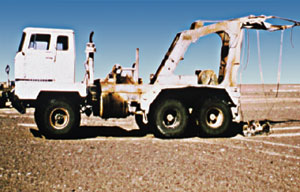 |
Fig. 1. Early weight drop system. Courtesy, Apache Corp.
|
|
Several unique shear-wave devices were developed in the early 1980s, such as CGG’s Marthor, Bolt’s Omni Pulse (an air gun fired at an angle to the surface), and Arco’s ARIS (an assisted weight that is dropped at an angle).2 Marthor was simply a truck with a large hammer that would smack a plate beneath the truck, Fig. 2. The resulting side-to-side force would create a dominant shear-wave signal.
 |
Fig. 2. Early CGG sources: (left) Marthor created shear waves with brute simplicity; (center) Flexotir used dynamite in a cage to try to diffuse the bubble; (right) Vaporhoc Octojet, was a marine source in which a quantity of superheated steam was injected into the water. Subsequent condensation of the steam attenuates bubble oscillation.
|
|
Offshore, the 1960s and ’70s brought the need for new marine sources, and several explosive and implosive devices were tried with the idea of eliminating the bubble effect. Flexichoc was an implosion source developed by IFP, where a partial vacuum is created between two locked plates, which, when triggered, collapse and create the impulse. Flexotir used explosives in a spherical cage, the idea being to disperse the bubble to prevent oscillations, Fig. 2. Vaporchoc was a bit of a hybrid explosive/ implosive source. It injected steam into the water to create the initial bubble pulse, which would immediately cool and collapse, Fig. 2. Water-jet guns, which expel water at high velocity, use the water’s inertial mass to form a partial vacuum. They are still in use today, such as Sercel’s high-frequency S15.
By the 1970s, the air gun had become the overwhelming favorite. It’s an impulsive source that releases compressed air into the water column, from a “gun” that is generally towed 15 to 30 ft beneath the surface. The bubble effect still exists, but these problems are overcome by shooting in large arrays of 15 to 30 guns, composed of different sizes. This produces a broad range of frequencies. Properly “tuned,” the energy will add coherently, increasing the energy that reaches the seafloor, while the bubble effects will add incoherently, smoothing them out. Processing can also play a role.
VENDOR OFFERINGS
One of the contradictions of a vibroseis truck, is that, although it is a lower energy source than explosives, its size and weight still often make it unsuitable on some roads, neighborhoods, and in certain environmentally sensitive areas, especially where tree cutting would be extensive. Apache Corp. was looking for a more environmental-friendly way to conduct seismic surveys. In the 1970s, CGG conducted surveys in the Swiss Alps by dropping heavy chains from a helicopter.
In late 2000, Apache dropped weights from a helicopter in an experiment to create a source that needed no road, required no tree cutting and was cost-effective. While technically feasible, it wasn’t practical, largely for safety reasons, because the weight could not be guided to a precise landing in areas with significant infrastructure. The company may revisit the idea, and use it in conjunction with flash-memory recording systems in remote areas.
Instead, in what is almost a throwback to the 1960s, a new weight-drop land source was funded by Apache. Working with Apache’s needs in mind, Polaris Explorer Ltd of Calgary designed and built the Explorer, a small buggy with a hydraulically assisted weight drop, Fig. 3. Like all weight drops, the frequencies generated are not as broad as vibroseis or explosives, and the higher frequencies attenuate more quickly with increasing depth.
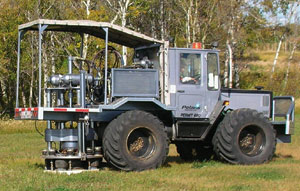 |
Fig. 3. Polaris Explorer’s hydraulically accelerated, weight-drop buggy, with 54-in. base plate.
|
|
However, costs are substantially reduced, due to the small footprint, fewer trees and lack of shot-hole drilling. As a bonus, permitting is easier. Apache has used the device to its advantage several times in Canada during the past 18 months.
Multi-azimuth acquisition is becoming increasingly essential, since, as one geophysicist put it, “Certain parts of the subsurface structure appear and disappear, depending on whether we image inline or crossline. We are completely unable to predict when this might occur.”3 On land, this is not a logistical problem. However, in marine acquisition, when it is desired for the source to be towed by a low-cost vessel, separate from the streamer vessel, the drivers are for lightweight, easy-to-handle sources that reduce present gun-array size and complexity. Another new situation is the arrival or permanent seafloor systems, with frequent 4D re-shoots. Simpler marine sources with less drag, easily deployed by a less expensive vessel of opportunity, will also be required for these surveys.
Toward that direction, Bolt is offering its Annular Port gun. The gun differs considerably from previous air gun designs. It has an annulus that contains the chamber and shuttle valve that surrounds a hollow passage, through which all air lines and firing lines are routed. Gun plates, cluster spreader bars, air manifolds and exposed air hose and electrical cable jumpers are eliminated, which also results in less drag, Fig. 4.
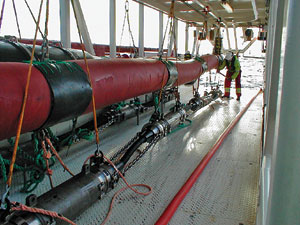 |
Fig. 4. Simpler design with Bolt’s Annular Port Gun eliminates gun plates, cluster spreader bars, air manifolds and exposed air hose and electrical cable jumpers.
|
|
Bubble geometry results in about 25% more output as compared to the company’s conventional air guns of the same volume, allowing for a smaller array, Fig. 5. The company has delivered four systems since August of 2003, with orders for six more. BP was the first user its Valhall field 4D project and has since ordered a second system.
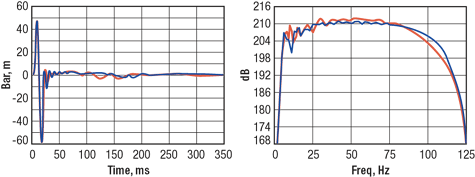 |
Fig. 5. 4,200-in3 conventional array (orange line), which contains 28 guns, vs. 3,720-in3 Annular Port Gun Array (blue line), which contains 21 guns. Signature modeled at 6 m. Time and frequency signatures are virtually identical.
|
|
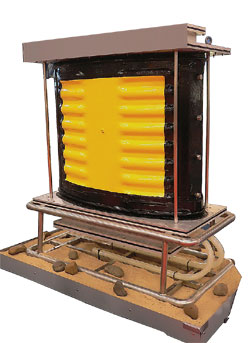 |
Fig. 6. New marine vibrating source from PGS can be towed or set on the seafloor.
|
|
|
| |
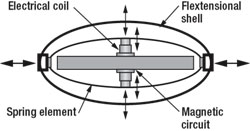 |
Fig. 7. PGS’ Electrical marine vibrator schematic.
|
|
|
| |
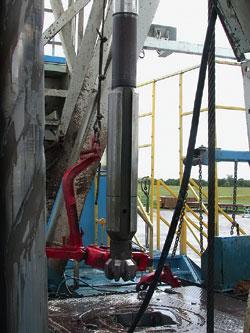 |
Fig. 8. Tempress’ impulsive downhole VSP/ SWD source in testing.
|
|
|
PGS recently introduced a new electro-mechanical marine vibroseis concept, Fig. 6. Two controllable output resonances, each in its own coil, achieve high efficiency and repeatability, one with 6-20 Hz output, the other with 20-100 Hz output, within a flexible shell, Fig. 7. The marine vibrator(s) produce energy penetration and frequency bandwidth comparable to a small air gun array or dynamite charge.
The vibrator(s) can function as a towed acoustic source in shallow water, or as a stationary source in transition zones. This idea has been worked on, for 10 years, more or less, and has been tested and compared to conventionally 2D and 3D acquired data, where it has been deemed comparable, with some advantages, particularly in the low frequencies. It has not been in commercial use, but is available to interested companies.
The vibrator requires only electricity and cannot leak hydraulic fluids. It is particularly well suited for applications in environmentally sensitive areas. Another area of potential use for the electric marine vibrator may be as a seabed source in permanent reservoir monitoring. When towed, the vibrators will need to be arrayed and mounted in a cage.
A new seismic-while-drilling-source has been developed by Tempress, Fig. 8. The downhole swept impulse, hydraulic source also aids drilling, in that it can increase ROP and reduce the likelihood of differential sticking. It also makes possible Seismic-While-Drilling (SWD) in soft formations and highly deviated boreholes. The are many benefits, a few of which are real-time pore-pressure prediction, depth-to-time correction, and drillstring VSPs. A Prototype tool has been developed in cooperation with the US Department of Energy and Baker INTEQ. The tool was beta tested in an inclined well using a PDC bit, both with and without a motor, where VSP and other data are known. The SWD velocities agreed with wireline values within 5%. S/N ratio was 10 dB or more from 40 to 120 Hz.4
In 2003, Russian firm Geoseis developed a new, skid-mounted, impulsive electromagnetic source, the GeoTon, for VSP work and for CDP imaging. The energy contained in a storage condenser is released and, through a transducer coil and an anchor, a mechanical force pulse strikes the earth. It is very small and maneuverable, Fig. 9.
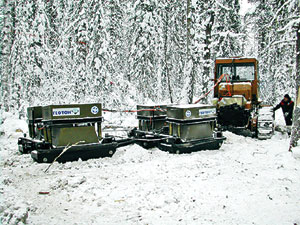 |
Fig. 9. The GeoTon, from Russia’s Geoseis, easily slides between trees.
|
|
KEEPING UP WITH CHANGES
Earlier, I mentioned that there were three basic elements needed for seismic reflection work: sources, receivers and processing. These three elements are interactive; thus, the utility one may change with advances in another. Years ago, an experiment in any one of these might have failed due to a shortcoming of another element. However, some of these experiments might need to be revisited in light of recent improvements.
For example, consider the plethora of shear wave sources developed in the 1980s. Shear-wave processing was in its infancy at the time, but numerous improvements in processing schemes would seem to indicate that, while there is still much to learn, over time, increasingly standard processing and interpretation models will evolve that will increase the utility of shear wave acquisition.
Polarized shear-wave sources are available, but nothing new has been introduced for at least the past 10 years, to the author’s knowledge. The present route of generating PS shear waves through offset P-wave sources appears to be sufficient, and, in any case, is certainly more practical. If pure shear-wave sources had an “Alba field” example, where the otherwise invisible field spectacularly appeared, things would be different.
But thus far, in limited use, even where 9C acquisition (3 polarized sources mapped in to 3-component receivers) has been tried, such sources have not proved essential to justify the added hassles of acquisition and processing. Still, such sources may yet have a future for near surface and fracture detection work, especially associated with subsidence.5 It will depend on our understanding of the appropriate geology where each source type is best used, as well as improved processing schemes.
Another example is the criticism that velocity-based geophones have inherent band-limiting low frequencies. However, new MEMS-based sensors, which use accelerometers, help mitigate this problem for multicomponent acquisition.2 Choosing the right low-frequency/ broadband source also helps.
Still another example is the advent of steerable streamers. These have allowed over/ under streamer configurations – towing streamers at two depths.6 This configuration preserves high and, especially, low frequencies that, in turn, encourages the use of larger-volume, lower-frequency sources for imaging beneath fast, absorptive formations, such as basalt.
Finally, deepwater ROV technology and deployment, combined with evolving autonomous node acquisition methods, open up new ideas about source deployment and design for wide- and multi-azimuthal acquisition. These acquisition geometries will become increasingly common, but only if the cost of source and receiver positioning continues to fall, and processing schemes are able to define and compensate for the considerable anisotropy that will be revealed.
Regardless of design, all seismic sources must deliver a consistent energy profile into the earth every time they are used, and they must also be carefully timed. This has become increasingly important as 4D repeatability has gained acceptance, leading to the evolving technology of precise digital source control. All of the major equipment providers have started offering such control.
With this interdependence in mind, it might pay oil companies to reconsider some of the sources that have fallen by the wayside, including new ideas for implosive sources for deep towing, geotechnical (site selection) and shallow seafloor properties. The “new” weight-drop and marine-vibrator sources are good examples. 
ACKNOWLEDGEMENT
The author thanks the following people for their assistance in procuring information and materials, and for helpful points: Denis Mougenot, Sercel, especially for his helpful technical points; Mike Bahorich and Dave Monk, Apache Corp.; John Andros, Bolt Technology; and Jack Kolle, Tempress.
LITERATURE CITED
1 Dragoset, B., “A historical reflection on reflections,” The Leading Edge, Vol. 24, No. S1, pp. 46-70, Oct. 2005.
2 Gaiser, J. and A. Strudley, “Acquisition and application of multicomponent vector wavefields: Are they practical?” First break, Vol. 23, June 2005.
3 Beaudoin, G., and S. Michell, spoken during presentation of, “The Atlantis OBS Project: OBS nodes – Defining the need, selecting the technology, and demonstrating the solution,” Paper OTC 17977, Offshore Technology Conference, Houston, 1-4, May 2006.
4 Kolle, J. J. and K. Theimer, “Seismic-while-drilling using a swept impulse source,” Paper 92114, SPE/ IADC drilling conference, Amsterdam, 23-25, Feb. 2005.
5 Jansen, J., “Seismic investigation of wrench faulting and fracturing at Rulison field, Colorado,” Thesis, Colorado School of Mines, 2003.
6 D. Hill, L. Combee and J. Bacon, “Imaging beneath basalt using an over/ under towed-streamers,” World Oil, May 2006.
|











